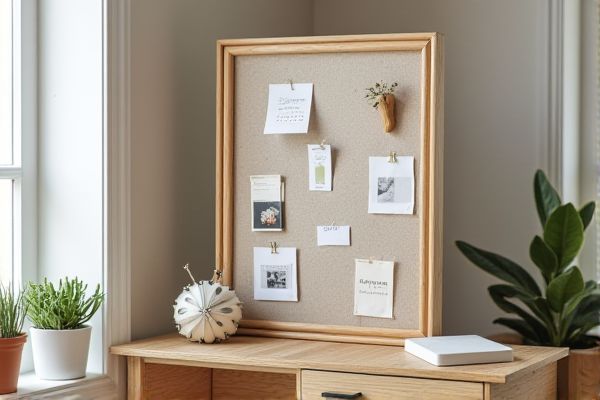
Felt boards provide a soft, textured surface ideal for securely displaying fabric pieces, letters, and lightweight decorations, while pin boards use cork or similar materials to hold notes and papers with pushpins, offering greater versatility for organizing documents. Explore the rest of the article to discover which board best suits Your needs and how to maximize their functionality.
Table of Comparison
| Feature | Felt Board | Pin Board |
|---|---|---|
| Material | Soft felt fabric | Cork or foam backing |
| Use | Attach felt-backed shapes, letters | Use push pins or tacks to hold items |
| Durability | Long-lasting with minimal wear | Pin holes accumulate, reducing lifespan |
| Maintenance | Easy cleaning, no holes damage | Requires patching or replacement over time |
| Ideal for | Educational settings, storytelling | Office memos, photo displays |
| Attachment Method | Static cling or friction fit | Push pins, thumbtacks |
| Visual Appeal | Bright, colorful interactive elements | Functional, customizable display |
Introduction to Felt Boards and Pin Boards
Felt boards and pin boards serve as versatile tools for organizing and displaying information in classrooms, offices, and homes. Felt boards use soft fabric surfaces that allow shapes and letters with felt backing to stick without pins, providing a tactile and safe way to create interactive displays. Pin boards, composed of cork or similar materials, rely on pushpins to attach notes, photos, or reminders, offering flexibility in arranging various paper items securely.
Material Composition: Felt vs. Cork
Felt boards consist of dense, non-woven fabric made from compressed wool fibers, providing a soft surface ideal for attaching lightweight items with felt-backed pieces or pins. Pin boards are typically made from natural cork, a renewable and porous material known for its durability and ability to hold push pins securely without damage. The key distinction lies in felt's smooth, tactile texture suited for reusable felt shapes, while cork offers a firmer, pin-friendly surface designed for versatile note and document display.
Design and Aesthetic Differences
Felt boards feature a soft, textured surface that allows easy attachment of felt shapes and letters, offering a cozy, tactile appeal ideal for classrooms and creative play areas. Pin boards, often made of cork or fabric-covered foam, present a more structured surface for pinning notes and photos, providing a classic, organized look suitable for offices and home workspaces. The choice between felt and pin boards hinges on desired aesthetic: felt boards create a playful, interactive environment, while pin boards deliver a clean, functional design.
Durability and Longevity Comparison
Felt boards feature a dense fabric surface that resists wear and tear, providing excellent durability for frequent use in classrooms or offices. Pin boards with cork surfaces may succumb to repeated hole damage over time, reducing their longevity compared to felt boards. Selecting a felt board ensures sustained performance and a longer lifespan in high-traffic environments.
Ease of Use and Pinning Options
Felt boards offer simple pinning with felt shapes that stick easily without damaging surfaces, making them ideal for quick display changes and kids' projects. Pin boards use pushpins or thumbtacks, providing more versatile attachment options for heavier items like documents or photos but can leave holes behind. Felt boards prioritize ease of use with reusable felt pieces, while pin boards excel in securely holding varied materials.
Maintenance and Cleaning Requirements
Felt boards require minimal maintenance, needing only occasional dusting or gentle vacuuming to keep the surface clean and free of debris. Pin boards, often made from cork, can accumulate holes and lose grip over time, requiring replacement or patching to maintain functionality. Both boards benefit from regular inspection to ensure pins or felt pieces remain secure and the surface remains intact for effective use.
Versatility in Home and Office Settings
Felt boards offer exceptional versatility in home and office settings by allowing easy attachment of letters, shapes, and cards without damaging surfaces, making them ideal for interactive displays and creative expression. Pin boards provide a durable option for securing documents, notes, and photos with push pins, ensuring quick updates and organization. Both boards support productivity and personalization, with felt boards favored for tactile engagement and pin boards preferred for sturdiness and frequent pinning.
Environmental Impact and Sustainability
Felt boards are often made from natural fibers like wool, making them biodegradable and more eco-friendly compared to pin boards that commonly use plastic and metal components with higher environmental footprints. The production of pin boards involves energy-intensive processes and materials that are less sustainable, contributing to landfill waste and resource depletion. Choosing felt boards supports sustainability goals by reducing synthetic waste and promoting the use of renewable resources in educational and office environments.
Cost Comparison and Value for Money
Felt boards generally offer a more affordable option compared to pin boards, with prices varying depending on size and brand but often costing less due to simpler materials. Pin boards provide durable, reusable surfaces suitable for heavier items, which can justify a higher initial investment if you need long-term functionality. Your choice should consider not only upfront cost but also how each board's durability and versatility match your specific needs for value.
Which Board is Right for You?
Felt boards are ideal for interactive storytelling, educational activities, and visual organization due to their soft surface and reusable felt pieces that easily stick without pins. Pin boards offer versatile display options for heavier items, important documents, and quick reminders with pushpins that securely hold papers and photos. Choose a felt board for creative, tactile engagement or a pin board for reliable, flexible pinning and office use.
 homyna.com
homyna.com